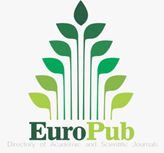A review on literature: How information and communication technology (ICT) supports circular economy for sustainable development
DOI:
https://doi.org/10.61511/seesdgj.v2i2.2025.1419Keywords:
information and communication technology (ICT), circular economy, supply chain management, circular business modelAbstract
Background: Information and Communication Technology (ICT) plays a crucial role in enabling the transition to a circular economy. By optimizing supply chain management and fostering innovative circular business models, ICT empowers businesses to reduce waste, conserve resources, and create more sustainable value chains. This research aims to explore the specific ways in which ICT supports the circular economy, including enhanced visibility and traceability, optimized resource allocation, improved collaboration, and the development of circular business models such as product-as-a service and sharing economy. Methods: This paper is qualitative research using Systematic Literature Review (SLR) from 275 papers that contained the relationship between ICT and circular economy as data, included 23 papers reviewed with SLR method. Findings: The result of this research is agreed that ICT has a role in circular economy. This research has explained that ICT can support circular economy through some aspects such as the advance, sustainability, efficiency through technology, etc. Conclusions: By leveraging ICT, businesses can transform their supply chains into circular systems, reducing waste, conserving resources, and creating long lasting value. Novelty/Originality of this article: Combining research from supply chain management and circular business model and the use of SLR method which is still little used.
References
Asif, F., Roci, M., Lieder, M., Rashid, A., Štimulak, M., Halvordsson, E., & Bruijckere, R. (2018). A practical ICT framework for transition to circular manufacturing systems. Procedia CIRP, 72, 598-602. https://doi.org/10.1016/J.PROCIR.2018.03.3 11.
Bocken, N., de Pauw, I., Bakker, C., van der Grinten, B., 2016. Product design and business model strategies for a circular economy. Journal of Industrial and Production Engineering, 33, 308–320. https://doi.org/10.1080/21681015.2016.1172124
Creswell, J. W. (1998). Qualitative Inquiry And Research Design: Choosing Among Five Traditions. SAGE Publications.
Demestichas, K., & Daskalakis, E. (2020). Information and Communication Technology Solutions for the Circular Economy. Sustainability, 12, 7272. https://doi.org/10.3390/su12187272.
Ellen MacArthur Foundation. (2016). Intelligent assets: Unlocking the circular economy potential. Ellen MacArthur Foundation. https://ellenmacarthurfoundation.org/intelligent-assets-unlocking-the-circular-economy-potential
Ellen MacArthur Foundation. (2019). Artificiaal Intelligence and The Circular Economy: AI as A Tool to Accelerate The Transition, Cowes: Google. Ellen MacArthur Foundation
Gecevska, V., Chiabert, P., Anisic, Z., Lombardi, F., Cus, F. (2010). Product Lifecycle Management throught Innovative and Competitive Business. Journal of Industrial Engineering and Management, 3(2), 323-336. https://doi.org/10.3926/jiem..v3n2.p323-336
Grady, J. S., Her, M., Moreno, G., Perez, C., & Yelinek, J. (2019). Emotions in storybooks: A comparison of storybooks that represent ethnic and racial groups in the United States. Psychology of Popular Media Culture, 8(3), 207-217. https://doi.org/10.1037/ppm0000185
Heyes, G., Sharmina, M., Mendoza, J., Gallego Schmid, A., & Azapagic, A. (2018). Developing and implementing circular economy business models in serviceoriented technology companies. Journal of Cleaner Production, 177, 621-632. https://doi.org/10.1016/J.JCLEPRO.2017.12.168.
Jum’a, L., Ikram, M., & Jabbour, C. J. C. (2024). Towards circular economy: A IoT enabled framework for circular supply chain integration. Computers & Industrial Engineering, 192, 110194. https://doi.org/10.1016/j.cie.2024.110194
Kirchherr, J., Piscicelli, L., Bour, R., Kostense Smit, E., Muller, J., Huibrechtse-Truijens, A., & Hekkert, M. (2018). Barriers to the Circular Economy: Evidence From the European Union (EU). Ecological Economics. https://doi.org/10.1016/J.ECOLECON.2018.04.028.
Kumar, N., & Chopra, S. (2022). Leveraging Blockchain and Smart Contract Technologies to Overcome Circular Economy Implementation Challenges. Sustainability, 14(15). https://doi.org/10.3390/su14159492.
LCDI. (2020). Ekonomi Sirkular. LCDI. https://lcdiindonesia.id/ekonomi-sirkular/
Lorek, P. (2020). The e-consumer as part of a circular economy. Informatyka Ekonomiczna. https://doi.org/10.15611/ie.2020.1.04.
Lingdi L., Wenyan, S., & Yang, L. (2023). Leveraging digital capabilities toward a circular economy: Reinforcing Sustainable Supply Chain Management with industry 4.0 technologies. Computers & Industrial Engineering, 178. https://doi.org/10.1016/j.cie.2023.109113
Mauersberger, A., Reinhardt, H., Alaluss, M., Mahdaviasl, M., & Ihlenfeldt, S. (2024). Overview of methodologies for the lifecycle management of smart product-service systems. Procedia CIRP, 128, 174–179. https://doi.org/10.1016/j.procir.2024.03.007
Okorie, O., Salonitis, K., Charnley, F., Moreno, M., Turner, C., & Tiwari, A. (2018). Digitisation and the circular economy: A review of current research and future trends. Energies, 11(11), 3009. https://doi.org/10.3390/en11113009
Pagoropoulos, A., Pigosso, D. C. A., & McAloone, T. C. (2017). The emergent role of digital technologies in the circular economy: A review. Procedia CIRP, 64, 19–24. https://doi.org/10.1016/j.procir.2017.03.012
Petre, A., Pleșea, D., Naumann, M., & Pitz, F. (2023). The circular economy as a driver for sustainable business development and the role of ICT. In New Trends in Sustainable Business and Consumption. https://doi.org/10.24818/basiq/2023/09/029
Ranta, V., Keränen, J., & Aarikka-Stenroos, L. (2020). How B2B suppliers articulate customer value propositions in the circular economy: Four innovation-driven value creation logics. Industrial Marketing Management, 87, 291–305. https://doi.org/10.1016/j.indmarman.2019.10.012
Rejeb, A., Simske, S. J., Keogh, J. G., & Treiblmaier, H. (2023). The role of blockchain technology in the transition toward the circular economy: Findings from a systematic literature review. Resources, Conservation & Recycling Advances, 17, 200103. https://doi.org/10.1016/j.rcradv.2023.200103
Rehman, A., Jajja, M. S. S., & Farooq, S. (2022). Manufacturing planning and control driven supply chain risk management: A dynamic capability perspective. Transportation Research Part E: Logistics and Transportation Review, 167, 102905. https://doi.org/10.1016/j.tre.2022.102905
Tamura, T., Kajikawa, Y., & Matsumoto, M. (2023). Proposal of an integrated design framework for ICT-supported circular economy business. Procedia CIRP, 116, 564–569. https://doi.org/10.1016/j.procir.2023.03.094
Trevisan, A. H., Zacharias, I. S., Castro, C. G., & Mascarenhas, J. (2021). Circular economy actions in business ecosystems driven by digital technologies. Procedia CIRP, 100, 325–330. https://doi.org/10.1016/j.procir.2021.05.122.
Uluturk, E., Le Dain, M. A., & Jarrahi, M. H. (2020). Digital technologies in circular economy transition: Evidence from case studies. Procedia CIRP, 90, 133–138. https://doi.org/10.1016/j.procir.2020.01.032
Yuan, S., & Pan, X. (2023). The effects of digital technology application and supply chain management on corporate circular economy: A dynamic capability view. Journal of Environmental Management, 345, 118543. https://doi.org/10.1016/j.jenvman.2023.118543.
Downloads
Published
How to Cite
Issue
Section
Citation Check
License
Copyright (c) 2025 Nicky Arnezti, Putri Maziya Ikhsanti, Denisya Ziva Alika, Faridatul Ummah, Muhammad Akbar Saputra, Muhammad Faisal, R. Candra Ahmad Syaukani Syaukani, Muhammad Addif Rayza, Zamsyah Dwi Hushaini Ramadhan

This work is licensed under a Creative Commons Attribution 4.0 International License.
















